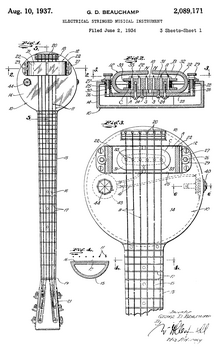Electro-Spanish Model B
Appearance
This article needs additional citations for verification. (May 2018) |
| Rickenbacher Electro-Spanish Model B | |
|---|---|
| Manufacturer | Rickenbacker |
| Construction | |
| Body type | Solid-Body, |
| Neck joint | Bolt on |
| Scale | 22.5" |
| Woods | |
| Body | Bakelite |
| Neck | Bakelite |
| Fretboard | Bakelite with pearl or paint dot inlay |
| Hardware | |
| Bridge | Vib-rol-a patented by Clayton Doc Kauffman
 |
| Pickup(s) | Horseshoe pickup
 |
| Colors available | |
| black/brown | |
Electro-Spanish Model B
The Electro-Spanish Model B was the world's first production, solid body (Bakelite) electrified lap steel guitar, officially released in 1935 by Rickenbacker. Commercially, it was the most successful musical instrument manufactured by Rickenbacker. Though not entirely solid - it had thick plastic (Bakelite) walls and a detachable Spanish neck. The instrument was created to eliminate the feedback found in conventional electrification of stringed instruments.[1]
The "Electro-Spanish Model B" set the stage for solid body guitars to develop; including the notable "Les Paul" whose electric solid-body would reach mainstream notoriety in 1952, produced by Gibson Guitar Corporation.
References
- ^ Rickenbacker, Rickenbacker. "Early History". Rickenbacker. Staff. Retrieved 18 August 2016.
